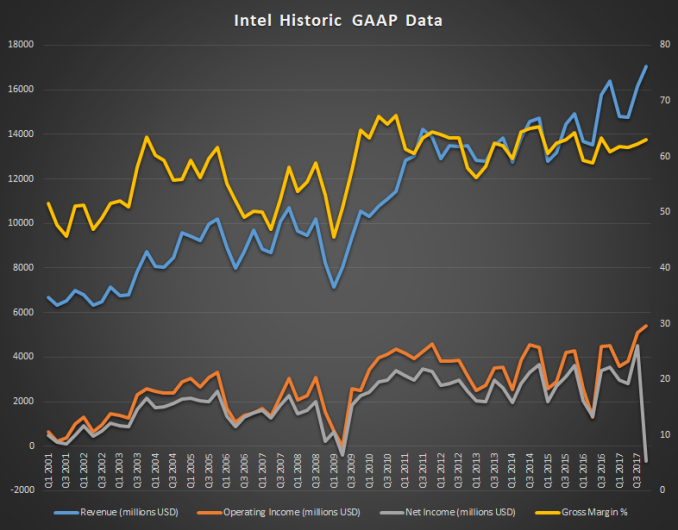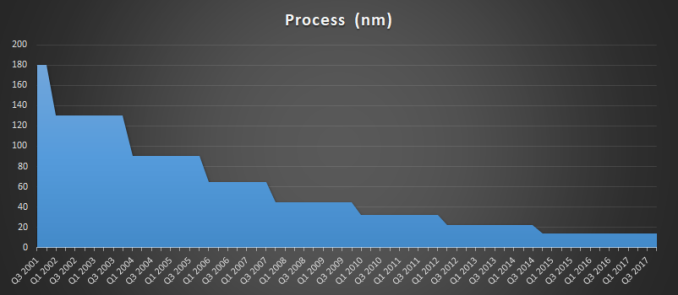Intel Announces Q4 2017 and FY 2017 Results
by Brett Howse on January 25, 2018 10:55 PM EST- Posted in
- CPUs
- Intel
- Financial Results

Today Intel announced their quarterly earnings, and 2017 was another record year for the company. Q4 revenue was a record $17.1 billion, and the full year revenue was a record $62.8 billion. For this quarter, Intel’s GAAP earnings took a hit due to a $5.4 billion tax expense thanks to the new tax reforms that were enacted in December, but as a one-time hit, it shouldn’t be a concern going forward. In fact, Intel is forecasting only a 14% tax rate for FY 2018.
In GAAP terms, Intel’s gross margin was 63.1%, which is up 1.4% from a year ago, and their operating income was up 19% to $5.4 billion. However, thanks to a 111.4% effective tax rate due to the one time $5.4 billion tax fee, Intel is actually reporting a GAAP loss for the quarter of $0.7 billion. Earnings per share were therefore down 120% to a loss per share of $0.15.
Due to the tax impact, it’s probably a good thing to look at Non-GAAP earnings as well which will exclude that one-time charge. In terms of Non-GAAP, Intel’s gross margin was 64.8%, which was up 1.7%. Operating income was up 21% to $5.9 billion. Intel’s Non-GAAP tax rate was 21.2%, which is actually higher than the 19.8% they paid last year, and net income was $5.2 billion, up 34% from a year ago. This led to earnings per share being up 37% to $1.08.
For the full year, Intel had $62.8 billion in revenue, with a gross margin of 62.3%. Operating income was up 39% year-over-year to $17.9 billion, although thanks to the tax hit their net income was down 7% to $9.6 billion. In Non-GAAP terms, net income was up 27% to $16.8 billion.
| Intel Q3 2017 Financial Results (GAAP) | |||||
| Q4'2017 | Q3'2017 | Q4'2016 | |||
| Revenue | $17.1B | $16.1B | $16.4B | ||
| Operating Income | $5.4B | $5.1B | $4.5B | ||
| Net Income | -$0.7B | $4.5B | $3.6B | ||
| Gross Margin | 63.1% | 62.3% | 61.7% | ||
| Client Computing Group Revenue | $9.0B | +1.6% | -2.0% | ||
| Data Center Group Revenue | $5.6B | +14.7% | +20.0% | ||
| Internet of Things Revenue | $879M | +3.5% | +21.0% | ||
| Non-Volatile Memory Solutions Group | $889M | -0.2% | +9.0% | ||
| Programmable Solutions Group | $568M | +21.1% | +35.0% | ||
Intel is still pivoting business away from the declining PC market, and they have done well to diversify, but still, their PC business is still the biggest piece of the pie. For the quarter, the Client Computing Group had revenues of $9.0 billion, which is down 2% year-over-year, but for the full year of 2017, their CCG was up 3% to $34 billion. It’s not quite dead yet. In an effort to show their diversification, Intel is now quoting their data in “PC-centric” and “Data-centric” and conveniently, Data-centric is all of their business outside of the CCG, but even so, the CCG still accounted for 53% of Intel’s revenue for the quarter.
But, the Data-centric group is certainly growing much quicker than the PC market which is still in a decline. The Data Center Group is by far the largest portion of Intel’s Data-centric efforts, and the DCG had revenues of $5.6 billion for the quarter, which are up 20% year-over-year. With the expansion of the cloud, this likely still has some ways to go before it hits a peak, so it’s likely just a matter of time before they finally surpass their Client Computing Group.
The rest of the Data-centric business was also up for the quarter, with IoT up 20% year-over-year, to $879 million. For the full year the IoT was up 20% and had revenues of $3.2 billion. Non-volatile memory was up 9% for the quarter to $889 million, and for the year it was up 37% to $3.5 billion. Programmable Solutions was up 35% for the quarter to $568 million, and for the full year, was up 14% to $1.9 billion.
Intel still hasn’t shipped anything on 10nm to the point where someone could go buy a chip, although we’re finally getting close, with Intel shipping 10nm to some of their partners. 14nm was delayed, but the delay in getting to 10nm has been longer than likely anyone expected. Intel has still made some bold claims about density, so it should be a good node for them if and when it arrives.
Intel’s forecast for Q1 2018 is for $15.0 billion in revenue, plus or minus $500 million, and despite the rough start to 2018, they are still forecasting another record year, with $65 billion in revenue, plus or minus $1.0 billion.
Source: Intel Investor Relations












42 Comments
View All Comments
caqde - Friday, January 26, 2018 - link
Meltdown does not affect AMD period. This is a known now as far as the rest. Yes it does affect ARM but not all of them. Intel is the only one where it affects all of their current processors. AMD is only vulnerable to spectre variants 1 and 2. Intel is vulnerable to all 3. So does it affect all processors yes, but not to the same extent. And as for AMD fanboys well they have a point in this issue AMD in this case is the least vulnerable as far as we know and from what we know so. Not to mention Intel is the most vulnerable at this point.https://www.amd.com/en/corporate/speculative-execu...
https://www.techarp.com/guides/complete-meltdown-s...
franzeal - Friday, January 26, 2018 - link
Part of the mitigations for these speculative execution attacks are updates to compilers. This is why you see nVidia, AMD, etc. issuing software patches (i.e. minimally they'll have re-compiled their binaries). AMD x86 CPUs are unaffected by Meltdown.Stop being a fanboy. Intel's primary response to this is to spread FUD.
franzeal - Friday, January 26, 2018 - link
Also, your little link amounts to speculation by someone out of their depth. You only have to follow the source to see as much; there's not a mention of AMD or ARM on the topic.Samus - Saturday, January 27, 2018 - link
Why are you spreading this fake news with bullshit links HStewart? Stop it. Do your research. AMDs prefetch architecture is immune to meltdown, like many (but not all) ARM designs, because the cache is exclusive to the instructions. This prevents some efficiency in prefetch performance where speculative execution can occur and is a hallmark of intels architecture going back to first gen Core (Nehalem) and even some Atom CPU’s. This is mostly an Intel only problem. And that isn’t because AMD is a fraction of the market. It’s becsuse it doesn’t affect them.Just stop it already. You are sounding like Trumps press secretary.
Tkan215 - Friday, January 26, 2018 - link
Next quarter or two will show.HStewart - Friday, January 26, 2018 - link
This sounds more of issue on OS and not just Intel in trouble with it - it also effects AMD and ARM chips also.For more detail information about issue and how it was found - the following technical website has more accurate information
https://spectrum.ieee.org/tech-talk/semiconductors...
If getting the government involved this - they would also have to look at other Chip manufactures and the OS. As for Intel and patches - they are no worst than anybody else - just they have more market and notice more.
Intel should have a successful year this year - with Raju on board and new graphics chips coming down plus like 10nm systems with longer battery life and higher performance.
If Government should be involved with anything in computer industry ( which I believe they should stay out completely ) is Qualcomm and there patient grabbing to try to have a real monopoly in telecommunications market.
HStewart - Friday, January 26, 2018 - link
One thing people are total forgetting, is how does this damaging code get on system. That is real problem - with this information out - it can actually cause such issues later. Maybe that was intentions of people that leak it - but they have shot AMD and ARM vendors also.Samus - Saturday, January 27, 2018 - link
It doesn’t affect AMD chips. It isn’t an OS problem. It doesn’t patch OS’s. Updates will be issued through OS updates because meltdown can be patched by updating compilers and Spectre can be patched with microcode, easier done through an OS firmware injection during boot than through a bios update that will be hard to get vendors to issue for EOL hardware.Stop it with the lies. AMD is not affected. The majority of ARM is not affected, including some Apple SoC’s. And stop linking to the same bullshit site that’s biting into all the Intel FUD.
haukionkannel - Saturday, January 27, 2018 - link
Yep, Intel will have very good year in 2018 if They release meltdown fixed prosessors Q4 in this year. Every company will buy new prosessors to replase old ones...So very good play From Intel to sell non fixed prosessors now and fixed later because it increases demand.
Not very fair towards customers maybe, but I am guite sure that 2018 is Intel best year of alltimes. If the fix does not come 2018 then 2019 is their best year, but then 2018 may be somewhat not so good.
StevoLincolnite - Saturday, January 27, 2018 - link
Or... Intel could capitalize on Meltdown and Spectre and thus could kick start a massive upgrade cycle. Although I doubt it.I am interested to see what people do though.
Personally I don't give a shit about either and happy to stick with my Sandy-Bridge-E which still handles everything effortlessly.